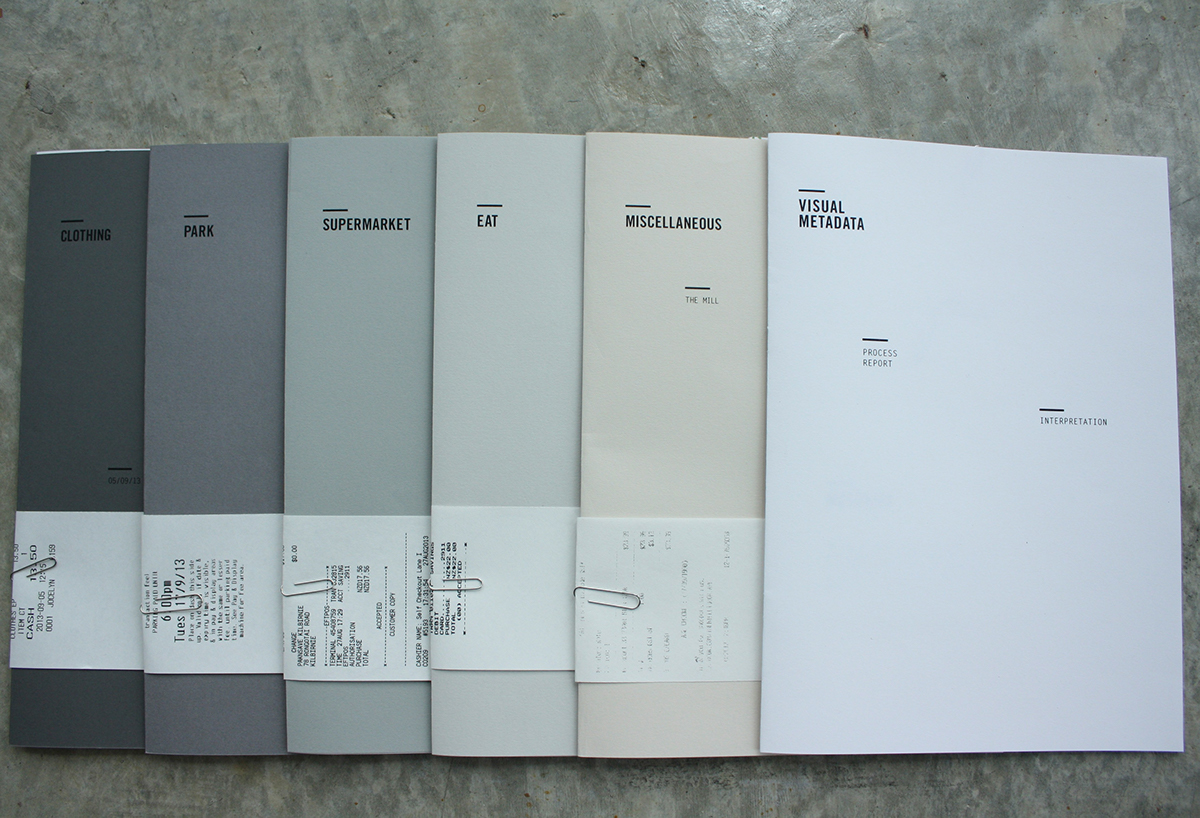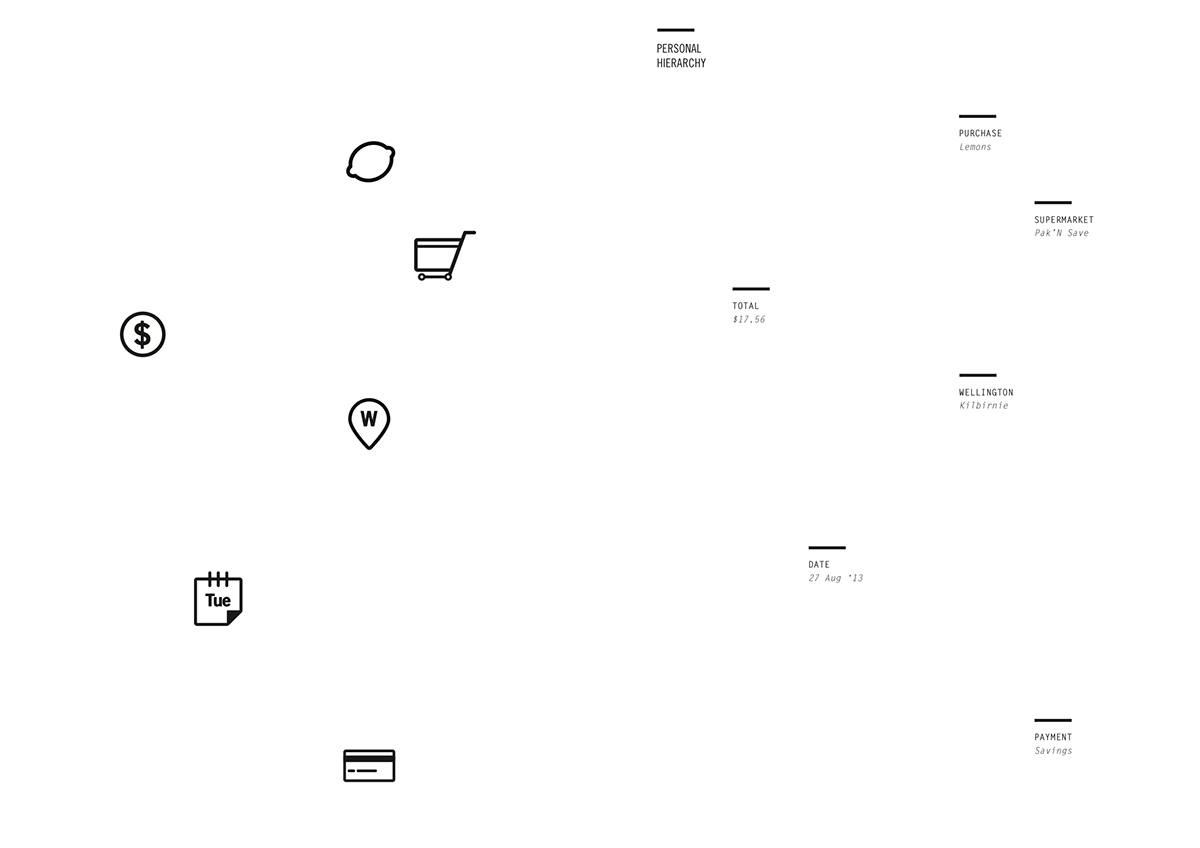Visual Metadata
- Honors Project
Metadata describes how, when and by whom a particular set of data was collected, how the data is formatted and is essential for understanding stored information.
Metadata is the data about data.
Visual Metatdata explores how graphic interpretation of data can be applied to the humble receipt, visually reproducing the content through the process of my own personal level of engagement and provoking consideration for how they function as a symbolic visual self-narrative.
I wanted to create a visual representation of each receipt on a personal level, by generating a process where the receipt data is broken down and then reformed in a dynamic typographical representation. The representation is based on the experience that I had had with that specific moment in time and drawing from the narrative that is inherently connected to the individual document which influences the hierarchal changes for each.
Throughout the course of an average day as a consumer, we collect and discard many ephemeral items these tangible items include things such as brochures, flyers, labels, tickets, packaging and receipts.
Visually, we encounter hundreds more, rarely conscious of the process of interaction with which we are engaged. And yet, these objects are important social signifiers, providing evidence through their physical appearance and methods of reproduction, how we engage as a consumer and how that is reflective of ourselves as a human being.

I created a series of booklets, one for each receipt, and sectioned under the categories of Clothing, Eat, Supermarket, Park and Miscellaneous, as well as having the beginning process booklet which helped the user understand the concept and method of interpretation.
The receipt displays many levels of coded information, most of which means little to us as consumers.
Every time we purchase something, we receive a receipt. That receipt is a trace and an identifier of our consumption and existence. In that receipt, there is a story.
From the receipts original hierachy of information, I created my own, this was based on what I believed to be the most important piece of information, to the least through my personal experience with having obtained the receipt.
I reflected on my own choice of hierarchy with a story outlining why certain things were in that order.
By bringing a humanistic intervention through the use of opinion, personal reflection, and symbolism it allows the receipt to be viewed as a personal story with intent rather than an empty template to be filled.
The back page reflects on the total money I spent during the purchase and what I received in return on a personal level.
Symbolic Treatment
The symbols reflect human intervention on another level, not digitalised codes and numbers that are found on receipts and added to an automatic database. They allow you to look deeper through the face value of numbers and jargon and are easily identifiable at a glance, drawing away from digital representation.
The symbols reflect human intervention on another level, not digitalised codes and numbers that are found on receipts and added to an automatic database. They allow you to look deeper through the face value of numbers and jargon and are easily identifiable at a glance, drawing away from digital representation. By bringing a humanistic intervention through the use of opinion, personal reflection, and symbolism it allows the receipt to be viewed as a personal story with intent rather than an empty template to be filled.
- Lemons
Today I went to the supermarket and stocked up on the biggest supply of fresh fruit and vit c. I have been quite sick lately so thought i would make some home made juices for a quick fix. I grabbed some ginger and lemons to speed up the process.



Process
I began the year by wanting to create curiosity through the mundane, our rituals, rules, and actions of the everyday.
I began the year by wanting to create curiosity through the mundane, our rituals, rules, and actions of the everyday.
Some theorists that have influenced certain aspects of my work are those such as Michel de Certeau, the author of The Practice of Everyday Life, which examines the ways in which people individualise mass culture, altering things, from practical objects to street plans and rituals, laws and language, in order to make them their own. Also that everyday life is distinctive from other practices of daily existence because it is repetitive and unconscious. Another theorist, Henri Lefebvre, who defined in The Critique of Everyday Life that without revolutionising everyday life, capitalism would continue to diminish the quality of everyday life, and inhibit real self expression.
These theorists as well as the book by Michael Foley Embracing the Ordinary gave me an insight to a deeper meaning in my project. I found the concept of ephemera intruiging, things that exist or are used or enjoyed for only a short time.
Receipt
The reason for choosing a receipt overany piece of ephemera is that it is, without our knowing, a very personal item of our existence, it is generated purely from our being, our exchange, our contribution to consumerism, and consumption therefore it is a digital representation of our existence at a certain moment of time.
Not only do receipts offer an insight into what has been purchased on a monetary level, they also record our social patterns and traces, as they provide evidence of every day experiences at the most basic and fundamental level. They also shed insight into our personal identity by creating a narrative bringing meaning into our lives through the inherent stories they tell about us.
Design
I generated my design to have a minimalistic aesthetic, which allowed me to strip back the jargon of code and non-essential information in the receipt. I did this by drawing attention to the hierarchy of information importance and exposing only the significant areas of content that held a certain meaning to myself. By using different paper stocks this allowed me to do this, showing my reflection and comment on the process for each document.
I applied the same system to each receipt, first gathering established hierarchy of text and code language, then applying my own hierarchy system to the receipt. Each personal hierarchy application was generated from the narrative that was attached to the receipt. I then went further to removing the receipt from the computer-generated system of information and text, codes and numbers that are automatically added to a database, unseen and buried. This was created by use of visually informative symbols, designed specifically by human intervention, for the human eye, rather than a pre coded digital file with set information layout.


